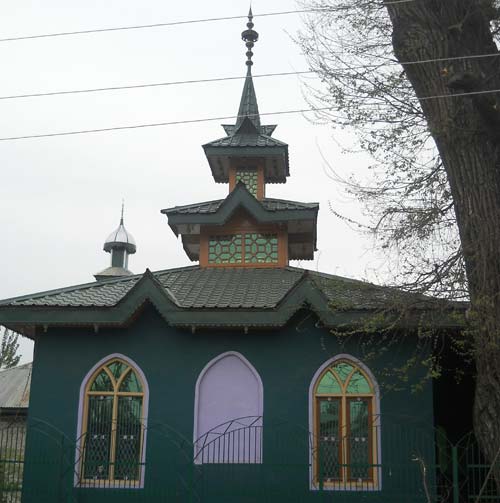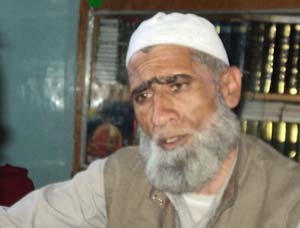An informal managerial arrangement at a Sufi shrine on the outskirts of Srinagar city which draws thousands of devotees every year has become a source of income for many villagers in Kirmaniabad. As Bilal Handoo finds out, new options are being explored to use the votive cash for the larger social good.

Situated some 10 km towards the western side of Srinagar, the shrine of Syed Ahmad Shah Kirmani (RA) is an important stopover for vehicles which pass on the National Highway that goes to Baramulla and further to Muzaffarabad on other side of the Line of Control (LoC). Many drivers offer votive money at the shrine before continuing their journey. The practice is not followed by all but those who do consider it as an act of catharsis.
The shrine is located in Kirmaniabad. The village got it name after the saint who is believed to have visited the area during the rule of Shahmiris. A temporary shed has been set up in front of the shrine complex near the National Highway where four men who act as caretakers of the shrine sit. These men remain on their toes throughout the day to collect money from a never ending rush of vehicles passing on the highway.
Every morning, four members of Gouripora Mohalla in Souzeth, a neighboring locality of Kirmaniabad, assume the role of attendants at the shrine. Mushtaq Ahmad, 18, is one among them. “People of Gouripora are the custodians of this shrine. The four volunteers at the shrine remain attentive at the shrine throughout the day,” Mushtaq claims.
At the end of the day, the cash collected at Syed Ahmad Shah Kirmani (RA) shrine is not handed over to Wakf Board, the state-appointed shrine managing body. The shrine is not under the control of Wakf Board. It has a separate managing body called Shah Kirman Committee.
Mohammad Ashraf Wani, who heads Shah Kirman Committee, claims the land under shrine belongs to Gouripora which, according to him, makes the residents of Gouripora default caretakers of the shrine. “Besides land, there are oral legends that the saint used to visit the house of one Akbar Dar of Gouripora,” Wani says.
“Though I am not fully aware whether the saint has ordered locals to be caretakers of the shrine, but one thing is for sure that people of Gouripora are default custodians of the shrine.”
As a hectic day draws to a close, each of the four volunteers has to mandatorily deposit Rs 500 in the shrine fund out of day-long collection of money. The rest of the money is divided equally among the four members. “Suppose, on any particular day, Rs 6,000 is collected at the shrine. It means Rs 2,000 would be deposited into shrine fund while the rest Rs 4,000 would be divided among the four shrine attendants,” Mushtaq says. “This is a norm set by the local shrine committee.”
At Lawaypora, Maulana Ghulam Mohammad Parray, a renowned religious scholar in the area, took me to a room in his house which is full of books on Islamic literature. Parray claims Syed Ahmad Kirmani (RA) had come to Kashmir from Kirman, a province in Iran, for the propagation of Islam in the valley. “There are certain historical records which suggest that Hazrat Kirmani (RA) spent some time at the place where the shrine now stands. Besides, he has also gone to other places in Kashmir as well,” Parray says.
Significantly, the most dominant influence on the Kashmiri Muslims is that of the Sufi orders like Suharwardi, Kubravi, Naqshbandi and Quadri, who arrived in Kashmir from Persia and Central Asia for the propagation of Islam. One of the Suharwardi Sufi who came to Kashmir was Syed Ahmad Shah Kirmani. He came to Kashmir during the reign of Sultan Nazuk Shah (1529-30, 1540-52). A Khanqah was built for him at Narwara in Srinagar and an annual grant was assigned to it from the state revenue. Among his disciples was Baba Masaud popularly known as Narwar Sahib.
“Saints and Rishis like Sheikh Nur-ud-Deen, Baba Bam-ud-Deen, Sheikh Hamza Makhdumi, Syed Ahmad Shah Kirmani, Syed Muhammad Hisari, and Baba Zain-ud-Deen by their example and precept smoothened the path of Islam in its slow, steady and systematic conversion of particularly the Kashmir valley,” Moulana Ghulam Mohammad Parray says.
At Kirmaniabad which is surrounded by vegetable fields, about three hundred resident families take turns after every two months to send their members who act as attendants at the shrine. And when they are not collecting money at shrine, they are either spotted working on their vegetable farms or busy in cultivation of vegetables. “We are not entirely dependent upon the earnings made out of shrine,” Sonauallah Bhat, an elder at shrine, says. “We treat it more as a pious duty on our part, set for us by our ancestors.”

The residents of Gouripora say that Wakf board authorities had asked them in the past to hand over the authority of shrine to them. “But many locals here objected to the move and compelled the authorities not to pursue the matter any further. The board then decided to keep the shrine under the custody of local committee,” Wani, who heads the committee, says.
Yaseen Qadri, vice-chairman, Muslim Wakf Board, says Syed Ahmad Shah Kirmani (RA) shrine doesn’t fall under the specified list of shrines notified by the state government. “The shrine at Kirmaniabad is being privately managed as it doesn’t figure in the list of shrines identified by the state,” Qadri says.
Mohammad Akbar Dar, a nominated villagehead of Gouripora locality says the major earning made from the shrine is spent for the welfare of destitutes, orphans and widows. “Besides, most of the income is being spent on the expansion of shrine property. Recently, few restrooms were constructed by the committee to allow for the night stay of people who come to pay obesience at the shrine from far flung areas,” Dar says.
Sometimes in the recent past, people of Gouripora recall that a saint called Lassa Babb from northern Kashmir visited the shrine and drew a circle around the boundary of the shrine. “Many people believe that the locals of Gouripora used to collect charity for shrine when it was not in prominent form,” Rashid Bhat, a local of Gouripora, says. “But soon after Lassa Babb visited, the shrine called the attention of many people from near and far flung areas.”
The rush at the shrine is apparent with a large number of devotees arriving at the complex with Tahri (rice prepared with turmeric) to serve it to other people who have come to pay obesience at the shrine. The rush at shrine reaches at peak on every 21th day of Ramzan. “It is the day of Urs at shrine,” Sonauallah, a shrine attendant for the day, says.
“On that day, it is obligatory for each and every family of Gouripora to bring chicken prepared with Tahri at shrine. All of us do it,” Sonauallah says.
Of late, many locals in Gouripora have begun to realize that the money collected at shrine could be utilized for larger good of the society, though they claims that some portion of charity is already being spent for such purposes. “I am one of those who spare a day at shrine to collect votive cash but I think this money can be used for larger social good,” Mohammad Subhan, a resident of Gouripora, says. “We could use the money to construct an Islamic seminary, apart from using it to help the underprivileged section of society.”















